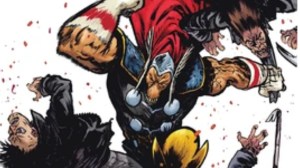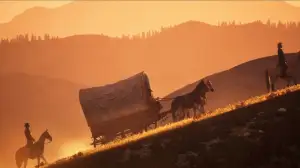
The month of October will begin with a magical new release at Image Comics: Blackbird. Created by artist Jen Bartel and writer Sam Humphries, the new series follows Nina Rodriguez, a young woman discovering a secretive world of magic operating behind the scenes in Los Angeles. The first issue alone is filled with fantastic creatures, arcane mysteries, and plenty of sisterly drama, promising one of the most eventful new Image series of the year.
Videos by ComicBook.com
ComicBook.com contributor Chase Magnett interviewed Bartel about the upcoming series, how it was developed, what makes it stand out, and how she is makes a big impression in Blackbird #1.
ComicBook: Would you tell us a little bit about how you first came to work on Blackbird?
Jen Bartel: Sam [Humphries] initially approached me at ECCC 2016 about potentially collaborating together, but he didn’t have a specific story in mind at that time. We then spent that spring and summer just kind of casually chatting about all our favorite pieces of media and what we wanted to see in comic shops, and by the fall we had created the initial pitch for Blackbird.
ComicBook: What was it that most drew your interest to this project in particular? Was there one particular moment where you thought, “This has to be my next comic?”
Bartel: I had very little experience when I first signed on to do it—Sam and everyone on our team put a lot of faith in me that I would be able to execute this project in a way that would do it justice, but I knew I had to do it because I was involved in all of the character development, story direction, and world building from the get go—Sam was incredibly open to writing a book that was tailor made for me and my strengths as an artist. It takes a very capable and confident writer to be able to do that well, I think.
ComicBook: One of the most captivating elements of Blackbird #1 is the slow introduction of magic. Both the Great Beast mentioned in the solicit and a variety of design elements show a lot of forethought and purpose. How did you go about designing the fantastic elements of this world?
Bartel: I think a big part of it is that Sam and I spent such a long time discussing how the magic world would function before anything was even scripted. We had created a system and really understood the mechanics of everything, so that gave me time to pull lots of visual inspiration that has both cultural and story significance—making things naturally richer. By the time issue one hits stands on October third, I’ll have all six issues of the first arc drawn, so we have had the privilege of working with a lot of runway and we’ve been able to work lots of Easter eggs and symbols in thanks to our long timeline.
ComicBook: There’s also a strong element of fashion design in the issue. Both Nina and her sister express themselves by what they wear and the magical figures of the comic possess some pretty tremendous outfits. What was your approach to crafting outfits for this wide range of characters?
Bartel: I really try to think about each character as if they are a real person—where would they shop, what would their style be, what’s their personality and how can their appearance reflect that—these are all important questions I ask myself before drawing anyone, because I think that when fashion is really considered and used correctly, it can help to tell a story about who these characters are. That’s always my goal when I’m drawing Blackbird.
ComicBook: One other influence I detected, both in the story and visuals, was that of the magical girl genre. It’s present in the visuals, the contrast of mundane life and the fantastic, and a particular pet. Is that a fair reading and, if so, what’s your connection to this genre of storytelling?
Bartel: Absolutely—I grew up with 90’s era Shōjo manga and anime like Sailor Moon, Magic Knight Rayearth, Card Captor Sakura, etc—I wanted to capture some of the elements that made those types of properties so intriguing to me as a teenager. At the end of the day, my goal with Blackbird was to create a comic that was fun to read, accessible, and was self-aware enough to reference some of its source material. It definitely does that, especially in some of the later issues.

ComicBook: Without giving too much away, I noticed there’s a contrast in your style between sequences in the mundane world and those that touch upon the magical with the latter often feeling more rich and detailed. Is that something readers can expect you to play with more as the series continues?
Bartel: Yep. Definitely. The magical world is extravagant, decadent, Los Angeles art deco fantasy, and the “regular” world is really showing LA the way that Nina sees it—she’s not hanging out in tourist spots, she’s walking down streets in North Hollywood with empty lots and earthquake damaged sidewalks.
ComicBook: The first issue strikes a really clear mood through the use of color and I’m curious who else is involved in bringing this series to life. Could you speak a little bit to your artistic collaborators on Blackbird as well?
Bartel: Yes! We’ve got an incredible team. Paul Reinwand is helping me with layouts on Blackbird, and because he’s so gifted when it comes to concept art and character designs, he’s helped me with some of the designs as well. He’s the first person who interprets Sam’s scripts, and sometimes I change things up, but it’s not usually necessary because he’s so good at what he does.
Nayoung Wilson helped to color issue one, and Triona Farrell is the series colorist from issue two and beyond. They are both amazing, and they both really understand my own color sensibility—which was imperative for this book because color is what really makes these pages what they are. I’ll sometimes make notes on the pages as far as what colors certain things need to be, and I’ll paint in effects and magic glows ahead of time, but most of the “atmosphere” of Blackbird comes from Triona, not from me. I can’t speak highly about her enough.
Jodi Wynne is our letterer extraordinaire—I wanted to hire as many women as I could on this project so I searched for a long time for the ideal female letterer, and she fits our project perfectly. It’s amazing how different and “complete” a page will look once letters are on.
Dylan Todd is our designer—he did our logo and he keeps everything looking really consistent and beautifully designed. He also puts together all of our issues for print, which is so helpful to me. And finally Jim Gibbons is our editor—he keeps the wheels on the bus and we couldn’t do it without him.
ComicBook: One final question that I always like to ask about new series: Is there anything in particular that you are most excited about readers seeing or responding to when the first issue is released?
Bartel: I’m just excited for readers to finally get to know this world and these characters that I’ve been drawing for the past six months—I think there’s been a lot of anticipation regarding what my interiors will look like, just because I’m coming from covers, so I hope I don’t disappoint!








